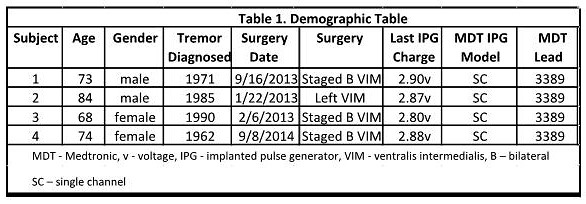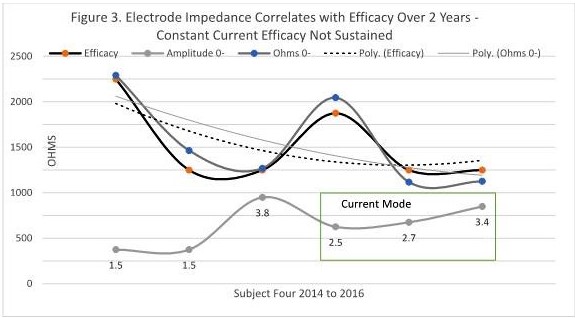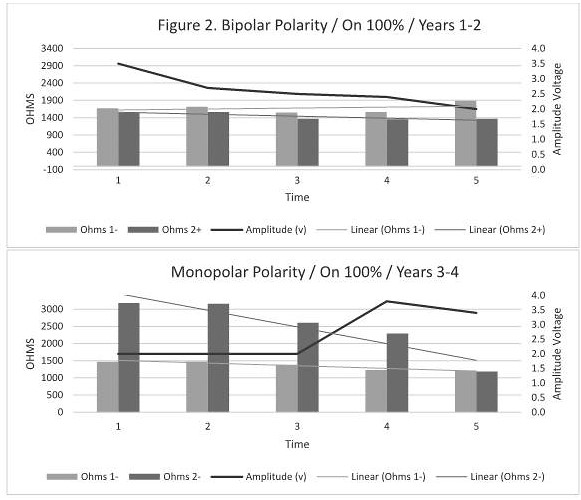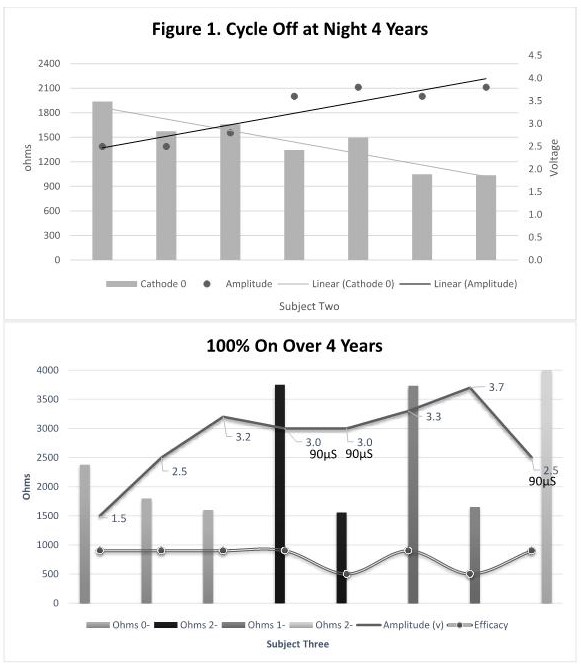Session Information
Date: Tuesday, June 6, 2017
Session Title: Tremor
Session Time: 1:45pm-3:15pm
Location: Exhibit Hall C
Objective: A review of programming strategies to maintain tremor suppression adequate for functional satisfaction.
Background: Deep brain stimulation (DBS) is FDA approved for Essential tremor since 1997. Long-term efficacy studies show sustained improvement as well as declines in functional benefit. Few effective programming strategies mitigate loss of therapy over time including stimulation holiday, stimulation off at night and constant current.
Methods: Four recently seen patients with thalamic DBS for Essential Tremor were selected for retrospective chart review (Table 1). Programming strategies used to maintain tremor suppression is reviewed using descriptive analysis. Standardized stimulation parameters used include pulse width from 60 to 90 microseconds and frequency from 130 to 185 hertz. Interleaving was not used due to pulse generator drain and authors noted lack of efficacy in prior patients. Patient reported functional tremor suppression and clinical exam were used to guide stimulation changes. Electrode impedance was noted at each visit.
Results: All patients initially experienced >90% tremor suppression, discontinued tremor medications and experienced gradual loss of efficacy. Decreased efficacy corresponded with steady decrease in active electrode impedance (ohms) regardless of stimulation on at all times or off at night (Figure 1). Strategies to regain efficacy included increasing stimulation power, activating a second cathode or changing to a cathode with higher ohms. All active electrodes had a notable decrease in ohms and conversely ohms increased once the electrode was inactivated. Bipolar polarity resulted in less fluctuations in electrode impedance but did not sustain efficacy (Figure 2). Cycling off at night did not prevent a decrease in ohms nor limit loss of efficacy. Constant current did not convey sustained benefit when switching from voltage mode (Figure 3). All patients reported delayed onset oral sensory change. No other stimulation side effects were reported.
Conclusions: In four patients, decreasing electrode impedance is a factor in loss of efficacy over time and correlated with delayed onset stimulation side effects. Tremor suppression can be maintained by adding or switching to an adjacent cathode with higher impedance. This strategy may depend on closely approximated electrode contacts such as the Medtronic lead model 3389.
Data displayed at DBS Expert Summit, Wurzburg Germany November 30, 2016.
To cite this abstract in AMA style:
S. Farris, M. Giroux. Novel Programming Strategy to Overcome Loss of Efficacy in Essential Tremor [abstract]. Mov Disord. 2017; 32 (suppl 2). https://www.mdsabstracts.org/abstract/novel-programming-strategy-to-overcome-loss-of-efficacy-in-essential-tremor/. Accessed March 29, 2025.« Back to 2017 International Congress
MDS Abstracts - https://www.mdsabstracts.org/abstract/novel-programming-strategy-to-overcome-loss-of-efficacy-in-essential-tremor/




